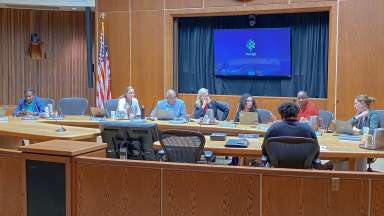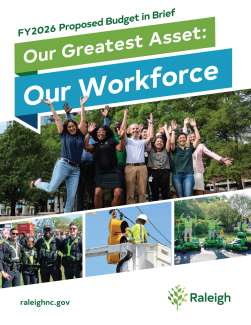Council Approves Budget
Update June 9, 4:50 p.m.:
The Raleigh City Council approved the budget unanimously with no changes. There will be no tax increase from Raleigh this year.
Helpful Links
The story below was originally posted on May 20, 2025 when the budget was first proposed.
Raleigh’s proposed $1.78 billion budget for FY26 supports the City’s workforce, makes strategic investments in services, and implements a financial strategy to give more transparency to capital projects. City Manager Marchell Adams-David presented the budget to Council on May 20.
The General Fund operating budget totals $657.1 million. This year’s biggest investment is to implement a classification and compensation study that better algins City employees’ job descriptions and salaries to the market. Investments in Dix Park, a second fire academy and cyber security are among the strategic expenditures that will ensure Raleigh delivers world-class services to its residents.
The capital budget of $616.9 million continues investing a penny of the property tax rate in affordable housing, parks operations, street maintenance, and pay-as-you-go projects, which do not rely on bond funding. Bond-funded projects The five-year Capital Improvement Program totals $2.5 billion for FY2026 – FY2030.
The FY26 budget achieves this without a tax increase, maintaining a property tax rate of 35.50 cents per $100 valuation. This is despite ongoing economic uncertainty, which is driving up the cost of City services and projects. Fee increases for Raleigh Water, Stormwater, and Solid Waste Services total $4.33 for the average homeowner.
The FY2026 proposed budget reflects the City’s commitment to the continued provision of high-quality services to residents through economic fluctuations. Through the first quarter of calendar year 2025, the City has seen a flattening in sales tax collections, which represent 19.4 percent of total general fund revenues. Property tax growth is budgeted slightly lower than normal, at 1.95 percent, due to higher than expected appeals on revaluations from last year and a slightly lower than expected collection rate in FY26.
To better position the city for future essential capital needs, the City is adopting the “Steady State” approach, a model that grants the City the flexibility to plan and implement projects according to priorities as the City continues to grow. This model makes direct contributions from revenue to the Debt Service Fund, enabling departments to begin planning large capital projects prior to proposing them for a bond or Council approval. Furthermore, planning will give the City a clearer understanding of the scope and cost of the project before the cost is approved by voters in a bond or by City Council. Because of this change, General Fund expenses declined by 10.3 percent. The taxes dedicated to capital projects will go directly into the Debt Service Fund, instead of passing through the General Fund.
The theme of the FY2026 proposed budget, “Our Greatest Asset: Our Workforce,” is illustrated by the implementation of a comprehensive classification and compensation study. The study has delivered a new structure for more than 7,000 employees in more than 450 different job types. The total funding required for implementation is $35 million. In anticipation of the study results, the City set aside a penny of the tax rate - $11.4 million – in FY25. The remaining resources to fund the compensation study were realized from savings and careful budget planning that still ensures a strong fiscal position for the organization.
Fiscal Year 2026 starts July 1 and runs through June 30, 2026. View the full budget.

